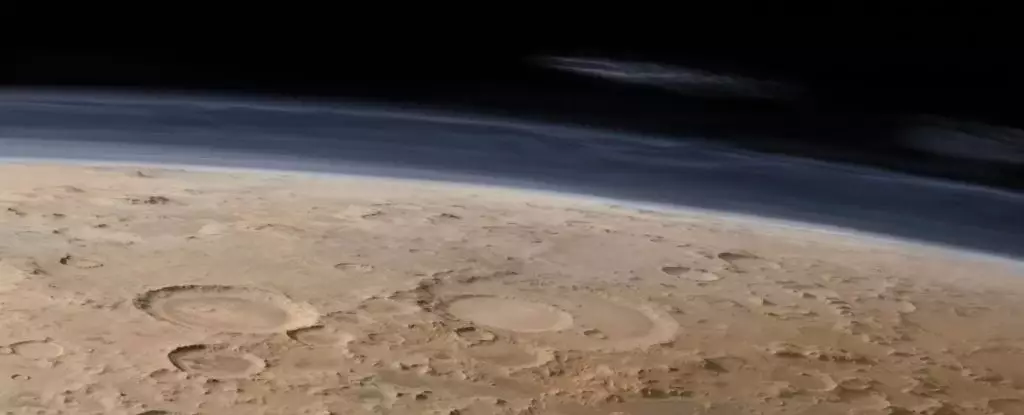The Martian environment has long fascinated scientists and space enthusiasts alike. Its thin, inhospitable atmosphere and the mysterious absence of widespread liquid water raise compelling questions about our neighboring planet’s past and potential for habitability. Recent groundbreaking research led by planetary scientist Shannon Curry at the University of Colorado Boulder has unveiled critical insights into how Mars lost its atmosphere and the ramifications for its water supply. After painstaking analysis of over nine years of data collected from NASA’s MAVEN (Mars Atmosphere and Volatile EvolutioN) mission, the research team has finally detected the elusive phenomenon of atmospheric sputtering. This phenomenon represents a pivotal mechanism in atmospheric erosion and is crucial for deciphering Mars’ environmental history.
The Mechanism of Atmospheric Sputtering
To understand atmospheric sputtering, it is essential to grasp the broader context of Mars’ atmospheric conditions. Unlike Earth, which is safeguarded by a robust magnetic field, Mars lacks sufficient magnetism to shield its atmosphere from the violent forces of the solar wind. Sputtering occurs when charged particles from the solar wind collide with Martian atmospheric atoms, transferring energy and allowing some of these atoms to reach escape velocity. This process can be likened to the energetic bursts produced when a meteor slams into a planetary surface. In this case, however, the “shots” are coming from the cosmos, and the victims are Mars’ own atmospheric particles.
The importance of atmospheric sputtering cannot be overstated. It is one of the primary reasons for the dramatic thinning of Mars’ atmosphere and the loss of considerable quantities of water that was once believed to be present. The research offers a clearer understanding of how solar activity in the early Solar System may have influenced atmospheric dynamics. By elucidating the role of sputtering in atmospheric loss, scientists can better reconstruct the conditions that prevailed on Mars millions or even billions of years ago.
A Groundbreaking Discovery from MAVEN Data
The journey to this discovery has been meticulous, requiring simultaneous data from multiple atmospheric layers and solar conditions. The MAVEN spacecraft, with its sophisticated instrumentation, has served as an invaluable tool in gathering the necessary information for this analysis. The team specifically focused on the correlation between the solar wind’s electric field and the varying densities of argon—a gas used to trace sputtering effects—at different altitudes above the Martian surface.
What the researchers found was nothing short of revelatory. Above 350 kilometers in altitude, the density of argon exhibits fluctuations depending on the orientation of the solar wind, contrasting with the stable argon levels found in lower atmospheric layers. Remarkably, these variations reflect the signatures of atmospheric sputtering, underscoring the dynamic and turbulent interaction between solar and atmospheric forces.
Additionally, a solar storm that occurred in January 2016 marked a significant moment in the team’s observations. The event amplified the sputtering effect, showing a marked increase in atmospheric argon density anomalies and reinforcing their hypothesis of ongoing atmospheric loss. The revelation that sputtering today is occurring at a rate over four times higher than previously estimated suggests that the current environmental conditions on Mars may be more complex and volatile than once thought.
Implications for Martian Habitability
The implications of these findings extend far beyond academic curiosity. Understanding the causes of Mars’ atmospheric erosion and water loss is essential for evaluating its past habitability. Numerous studies suggest that Mars once hosted significant bodies of liquid water, which are now difficult to reconcile with its current barren landscape. The identification of sputtering as a significant factor in atmospheric depletion helps clarify the timeline and processes that governed the planet’s transformation.
Furthermore, these insights could inform future missions to Mars, particularly in assessing the viability of colonization or the search for microbial life. As scientists continue to explore the Martian surface and atmospheric conditions, this fine-tuned analysis of atmospheric sputtering will be integral to developing a comprehensive understanding of Mars’ ecological and environmental history.
In a realm where planetary science intersects with existential questions about life beyond Earth, discoveries like these affirm the importance of continued exploration of our solar neighbor. As research continues and technology advances, the ongoing saga of Mars may yet reveal its secrets, reshaping our understanding of habitability in the cosmos.


Leave a Reply